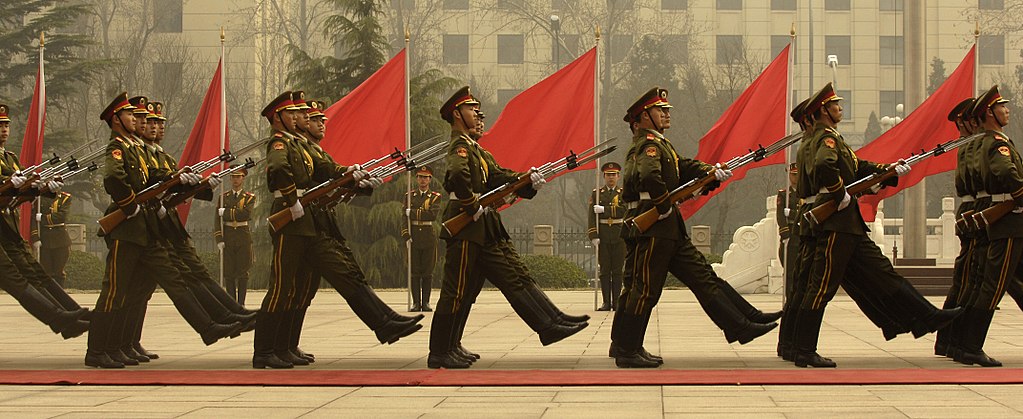US defense companies helped China build its military until the fall of the Soviet Union

Members of a Chinese military honor guard march during a welcome ceremony for Chairman of the Joint Chiefs of Staff Marine Gen. Peter Pace at the Ministry of Defense in Beijing, China. (U.S. Air Force photo)
SUMMARY
The Cold War is often portrayed as an epic struggle between East and West, between Communism and Capitalism, and the Evil Empire against the Free World. Much of Cold War history, however, ignores the effects of Chinese communism on the Cold War.
To understand how the United States helped build the Chinese military, it’s important to understand how Chinese communism turned away from the Soviet Union and why it would turn to a Western power for help.
China and the Soviet Union originally got along very well after both countries turned red. They were both wholly devoted to the spread of international communism and even fought side-by-side in many areas, including against the United Nations in Korea.
It all began to unravel in the wake of Soviet leader Joseph Stalin’s death. China was still dedicated to the Iron Fist form of Stalinist communism. Soviet Premier Nikita Khruschev took a softer tone with spreading Soviet communism and in 1953, the two countries began to split apart in their worldview.
This didn’t disrupt China’s aggression toward the United States during much of the Cold War. It still helped support communist regimes in North Korea, Albania, and even North Vietnam as it fought off American troops in the 1960s and 1970s. Then, Chinese relations with the West took an unexpected turn, this time it turned toward a former storekeeper from California: President Richard Nixon.
Nixon, a lifelong ardent anti-communist, surprised the world when he began to openly thaw American relations with the People’s Republic in 1972. It was an elite power move, a rapprochement with a former enemy that also dealt a huge blow to the U.S.’ prime enemy, the Soviet Union. Communist countries around the world had no idea how to react.
In China, anti-American propaganda all but disappeared and the two countries actually began to work together on a number of geopolitical issues, including insurgencies in Africa, containing the Soviet Union in Afghanistan and monitoring Soviet movements along the Chinese border. As of 1979, China began receiving American arms sales.
But China’s military still suffered from massive amounts of outdated and obsolete military hardware and weapons. The United States began to help China rebuild its military to form a more solid ally in the effort against the Soviet Union. To do this, Americans brought technological upgrades to Chinese weapons systems.
There’s no better example of a technological upgrade than the Jaguar Main Battle Tank project that the United States and China shared. In 1988 American manufacturer Cadillac Gage and the Chinese National Machinery and Equipment Import and Export Corporation (CMC) jointly developed a new main battle tank system based on the Soviet T-55. The Jaguar would become the centerpiece of the Chinese People’s Liberation Army for the years that followed.
It was a relatively simple idea, taking the outdated Type 59 MBT and integrating advanced weapons technology from the West into its design. It was a solid tank, after all, if only just slightly outdated. Essentially, the Jaguar was the best of both worlds, built cheaply by Chinese labor and incorporating the best tank tech from the West.
The Jaguar program came with little risk to the US military or its interests. Even in 1988, the M1A1 tank was one of the most advanced and most formidable weapons found anywhere in the world. The Jaguar was supposed to be cheap, widely available and mass produced at 1/4th of the cost of a Abrams, and that was its main selling point.
What it had that the Chinese Type 59 didn’t have was a British-made 107mm cannon and 7.62mm mounted machine guns, features that are still a mainstay of the Chinese PLA. Western defense companies also fitted it with night vision and a laser rangefinder, as well as a hugely upgraded Digital Fire Control System.
The Jaguar also had increased armor protection and sloping that would help protect crews from some of the newest weapons fielded by the Soviet Union, which made it heavier. But the western companies simply upgraded the engines to help give it more pickup on the roads. Within a year, the Jaguar was being field tested.
Had it not been for the Tiananmen Square Massacre of 1989, Chinese and Western defense cooperation might have continued. After the fall of the Berlin Wall that same year, the interest in building new tanks disappeared along with the USSR and the program simply faded away.
SHARE
